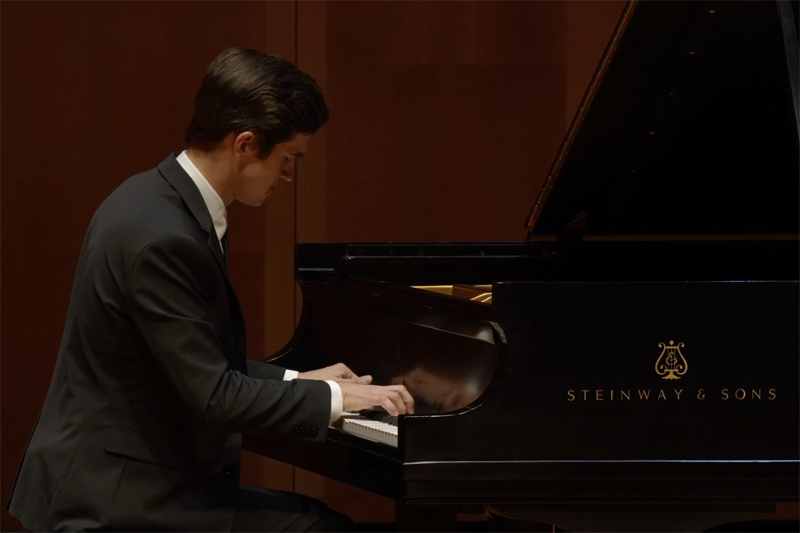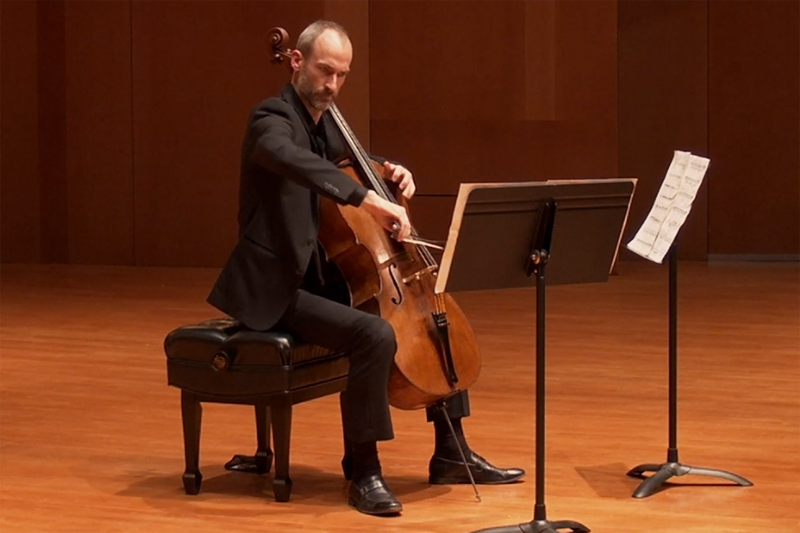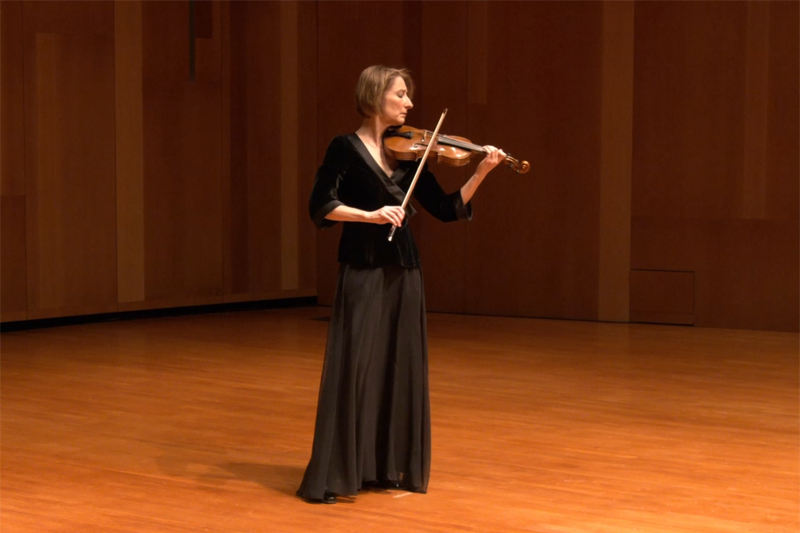Pianist Cahill Smith fits nicely into the NOVA Chamber Music Series’ family, as well as the Utah State University music school in Logan. Take the following example. In two Carnegie Hall recitals, respectively in 2013 and 2015, he dedicated his performances to works by Russian composer Nikolai Medtner, a far less known contemporary of Sergei Rachmaninov, at least to many American audiences.
Smith, an Alabama native, first encountered Medtner’s music during his college days at the University of Alabama at Birmingham when he was assigned the composer’s pieces by Yakov Kasman, the Russian-born pianist who won the silver medal at the Van Cliburn International Piano Competition in 1997. Eventually, it would become Smith’s “grand mission,” as he describes in an interview with The Utah Review, fortifying assurances that performances of Medtner’s music are not limited to rare occurrences. “There is so much joy and beauty in his outlook,” Smith explains about his passion for the composer’s music. In a recorded interview with Fry Street Quartet cellist Anne Francis Bayless, as part of NOVA’s podcast series, Smith says, “I guess the common criticism of Medtner is that his music is old-fashioned. That he was content to stay with the harmonic vocabulary of Brahms, maybe… Brahms plus, I’ll say… All the way until the 1950s. So writing this traditional tonal music in a lot of traditional forms, but trying to say something new with them.”
Indeed, one part of NOVA’s multifaceted artistic mission — which is being carried out exquisitely by the organization’s music directors who happen to be all the members of the Fry Street Quartet — has been to introduce audiences to music from both familiar and unfamiliar composers that is seldom performed and do so in creative ways that elucidate novel connections between the past and present.
In NOVA’s final offering of its filmed spring concert series, Smith performs four short selections from Medtner’s solo piano works. The music is a rich Romantic varietal — a robust synthesis with hints bringing up memories of Debussy, Brahms, Schumann and Schubert along with Rachmaninov. And, of course, the lyricism is bolstered by technical heft and muscle just as impressive as what would be found in the great piano literature that electrifies international competitions.
In the performance, Smith curates an ideal sampler to introduce viewers and listeners to a composer, whom he hopes people will be motivated to learn more about, as they deepen and lengthen their appreciation of chamber music. Smith’s selection includes what is believed to be Medtner’s earliest work, written when he was in his teens (in the mid-1890s): Prologue: The Angel from Eight Mood Pictures, op. 1, no. 1. The piece, which the composer would later recast as a song, features an awkward challenge for the pianist, who must use the thumbs to play the notes of the melody. The Prologue is an effusive burst of youthful ingenuity, a spirit Smith nails expressively and technically.
The other three works, which come from the composer’s ironically titled Forgotten Melodies collections, also produce different emotional impacts. Smith does full melodic justice to the Canzona serenata, which would produce the perfect mood in a moonlit setting at midnight. Smith’s innate instincts for lyricism in his Medtner performances come from a sideline passion for the song form, which he cultivated as a graduate student while accompanying vocalists.
Meanwhile, Meditazione, with a surprising take on its title, is a jolt out of the pure serenity of the night song that Smith just performed. The mood for this one is anxious, restless and disturbed, with the listener wondering when it will actually resolve in the harmonic cadence one might expect from Medtner’s music. It finally does occur but Smith’s confident interpretation of the piece’s tempestuous character also indicates just how much the artist has delved into interpreting this composer’s expressive language. Smith finishes with Primavera, a lovely palate cleanser delivered proudly and delightfully by an artist who passionately takes up the advocacy role for ascertaining the Russian composer’s place in music history.
Smith’s pedagogical philosophy syncs up with his colleagues in Logan, including the Fry Street Quartet, which is in residence at Utah State. As a teacher in the 21st century, Smith, who joined the Utah State music faculty in 2019, is sensitive to the benefits and limitations of having unparalleled convenient access to recordings, thanks to social media platforms. As tempting as it is to become a YouTube or Tik Tok junkie, Smith says it also is an opportunity for students to go beyond the music they’re assigned to study by opening their minds and ears to become more sensitive listeners. He acknowledges that this is a lifelong task for everyone (including himself) — teachers, students, performing artists, conductors, ensembles and audiences. Just as vital as his passion for Medtner is Smith’s love of country and bluegrass music, which was part of the musical vocabulary he encountered when he was growing up in Alabama.
As with many piano students in college, Smith was responsible to accompany other musicians periodically. Eventually, he recognized that it was not just a task but also a chance to broaden his exploration into many dimensions of music. Through these experiences, he discovered his love for the lyrical poetry in songs from Germany, Russia and elsewhere. As a trumpet player, he enjoyed the rewards of performing in pit orchestras for musical theater.
This latest spring concert, just under 45 minutes in length, includes a short piece by Andrew Norman, a contemporary composer whose work has comprised some of the most memorable live performances in NOVA’s recent history. Such praise also is due in the recorded performance of Sabina by cellist Walter Haman. Sabina is a versatile work, originally composed as the last movement for a 2006 string trio The Companion Guide to Rome. Norman, who lives in Los Angeles, has scored the work as a solo for violin, viola or cello. This work signifies Norman’s exceptional skill at manifesting recollections of magnificent architecture in his music. Norman wrote this based on an early morning visit to the 5th century home of the Dominicans — the Santa Sabina church on the Aventine Hill in Rome. Haman’s interpretation is as breathtaking as the inspiration for the piece.
The concert concludes with an intriguing feature that has suited the social distancing requirements of the pandemic — featuring collage performances of Bach’s music. Five violinists, each taking up a single movement, perform Bach’s Partita in E Major for Solo Violin, BWV 1006, one of the most famous solo violin works. The collage demonstrates a point that bears repeating and repeating in Salt Lake City. For a city of this size, the quality of string players and the depth of the bench of available musicians make it easy to assemble a collage performance of outstanding quality. It is a fascinating exercise: five different artistic perspectives in a single work yet each one displays magnificent technical skill and equally compelling interpretations. Featured are Kathryn Eberle (Preludio), Laura Ha (Loure), Rebecca McFaul (Gavotte en Rondeau), Hannah Linz (Menuets I/II) and Alex Martin (Bourrée and Gigue). While the collage idea originated as a logistical solution in which each violinist records a movement at home, the impact is so satisfying that it is worth using occasionally as a concert feature when NOVA returns to live performances.
The other three concerts of the 2020-2021 series, including Rising Tide, also are available online. For more information, visit the NOVA Chamber Music Series website.



